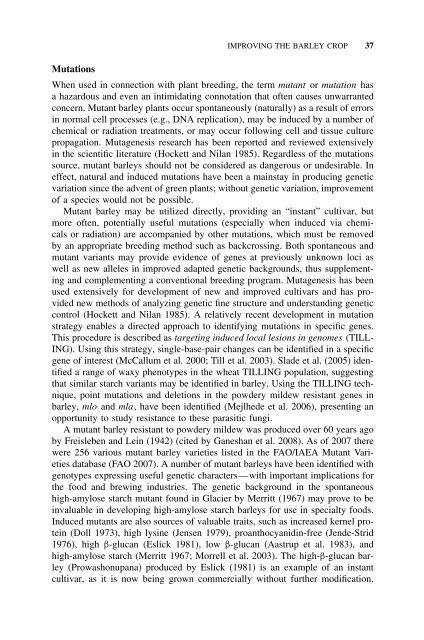Barley for Food and Health: Science, Technology, and Products
Barley for Food and Health: Science, Technology, and Products
Barley for Food and Health: Science, Technology, and Products
You also want an ePaper? Increase the reach of your titles
YUMPU automatically turns print PDFs into web optimized ePapers that Google loves.
IMPROVING THE BARLEY CROP 37<br />
Mutations<br />
When used in connection with plant breeding, the term mutant or mutation has<br />
a hazardous <strong>and</strong> even an intimidating connotation that often causes unwarranted<br />
concern. Mutant barley plants occur spontaneously (naturally) as a result of errors<br />
in normal cell processes (e.g., DNA replication), may be induced by a number of<br />
chemical or radiation treatments, or may occur following cell <strong>and</strong> tissue culture<br />
propagation. Mutagenesis research has been reported <strong>and</strong> reviewed extensively<br />
in the scientific literature (Hockett <strong>and</strong> Nilan 1985). Regardless of the mutations<br />
source, mutant barleys should not be considered as dangerous or undesirable. In<br />
effect, natural <strong>and</strong> induced mutations have been a mainstay in producing genetic<br />
variation since the advent of green plants; without genetic variation, improvement<br />
of a species would not be possible.<br />
Mutant barley may be utilized directly, providing an “instant” cultivar, but<br />
more often, potentially useful mutations (especially when induced via chemicals<br />
or radiation) are accompanied by other mutations, which must be removed<br />
by an appropriate breeding method such as backcrossing. Both spontaneous <strong>and</strong><br />
mutant variants may provide evidence of genes at previously unknown loci as<br />
well as new alleles in improved adapted genetic backgrounds, thus supplementing<br />
<strong>and</strong> complementing a conventional breeding program. Mutagenesis has been<br />
used extensively <strong>for</strong> development of new <strong>and</strong> improved cultivars <strong>and</strong> has provided<br />
new methods of analyzing genetic fine structure <strong>and</strong> underst<strong>and</strong>ing genetic<br />
control (Hockett <strong>and</strong> Nilan 1985). A relatively recent development in mutation<br />
strategy enables a directed approach to identifying mutations in specific genes.<br />
This procedure is described as targeting induced local lesions in genomes (TILL-<br />
ING). Using this strategy, single-base-pair changes can be identified in a specific<br />
gene of interest (McCallum et al. 2000; Till et al. 2003). Slade et al. (2005) identified<br />
a range of waxy phenotypes in the wheat TILLING population, suggesting<br />
that similar starch variants may be identified in barley. Using the TILLING technique,<br />
point mutations <strong>and</strong> deletions in the powdery mildew resistant genes in<br />
barley, mlo <strong>and</strong> mla, have been identified (Mejlhede et al. 2006), presenting an<br />
opportunity to study resistance to these parasitic fungi.<br />
A mutant barley resistant to powdery mildew was produced over 60 years ago<br />
by Freisleben <strong>and</strong> Lein (1942) (cited by Ganeshan et al. 2008). As of 2007 there<br />
were 256 various mutant barley varieties listed in the FAO/IAEA Mutant Varieties<br />
database (FAO 2007). A number of mutant barleys have been identified with<br />
genotypes expressing useful genetic characters—with important implications <strong>for</strong><br />
the food <strong>and</strong> brewing industries. The genetic background in the spontaneous<br />
high-amylose starch mutant found in Glacier by Merritt (1967) may prove to be<br />
invaluable in developing high-amylose starch barleys <strong>for</strong> use in specialty foods.<br />
Induced mutants are also sources of valuable traits, such as increased kernel protein<br />
(Doll 1973), high lysine (Jensen 1979), proanthocyanidin-free (Jende-Strid<br />
1976), high β-glucan (Eslick 1981), low β-glucan (Aastrup et al. 1983), <strong>and</strong><br />
high-amylose starch (Merritt 1967; Morrell et al. 2003). The high-β-glucan barley<br />
(Prowashonupana) produced by Eslick (1981) is an example of an instant<br />
cultivar, as it is now being grown commercially without further modification.

















